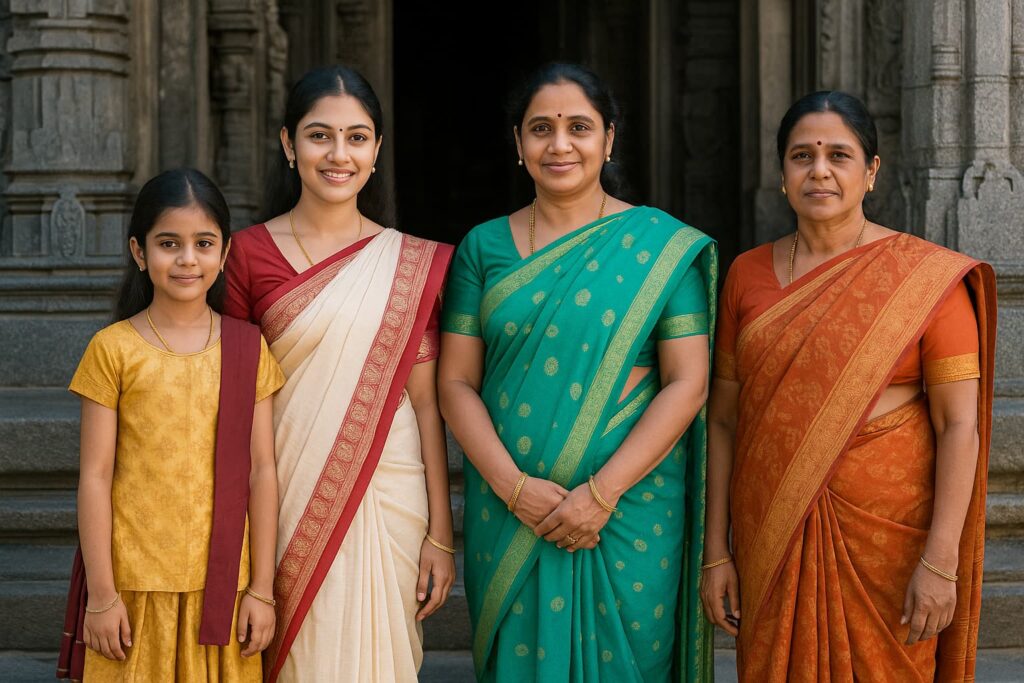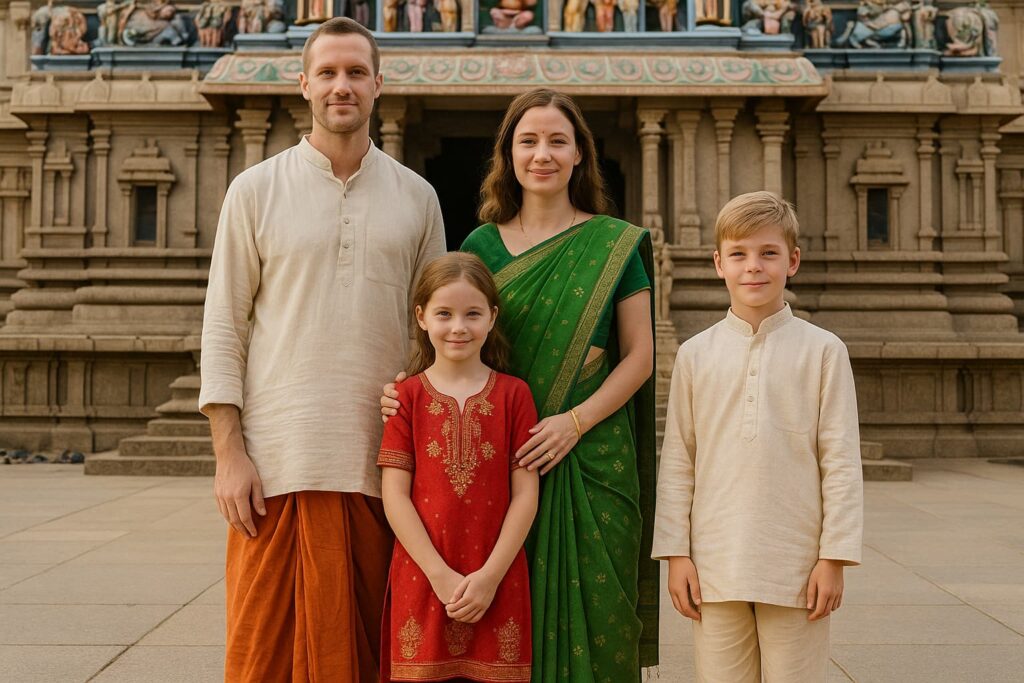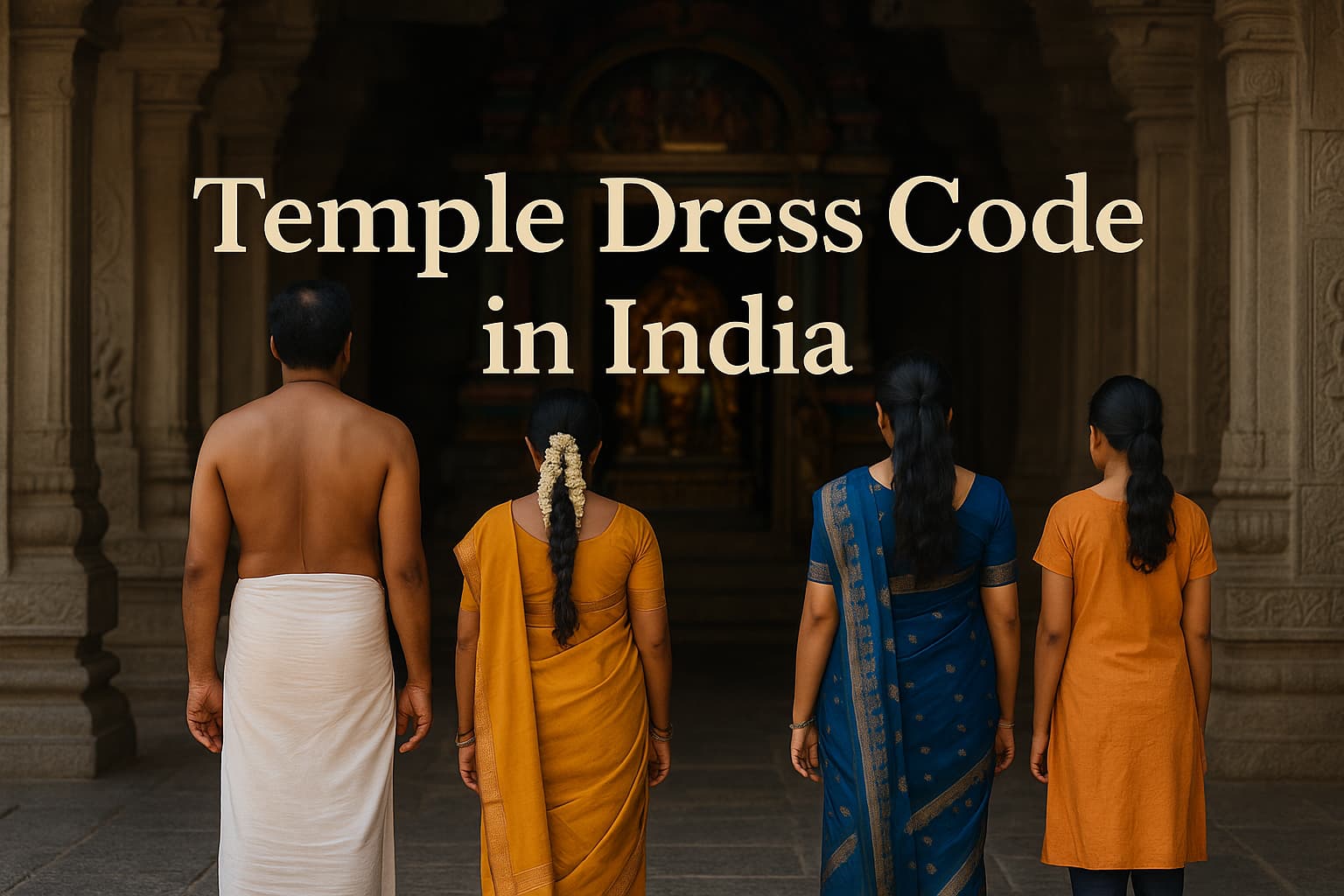Temple dress code in India isn’t just about rules — it’s a reflection of spiritual respect and cultural tradition. Temples across the country are considered sacred spaces where devotion begins not with words, but with how we present ourselves. Just as we remove our footwear before entering, dressing appropriately is a silent offering of humility. Whether you’re a first-time visitor, a regular devotee, or a curious traveler, this guide will help you understand what to wear during a temple visit, the spiritual meaning behind modest attire, and how dress expectations vary across regions.
🪔 Why Does Dress Code Matter in Indian Temples?
In Indian spiritual culture, how we present ourselves is just as important as what we offer. Temple dress code in India reflects a deep-rooted sense of devotion — dressing modestly is not merely a social custom, but a symbolic act of inner humility.
✨ “Attire is not just cloth — it is character in silence.”
Temples are considered pure and divine spaces. Wearing flashy or revealing outfits may disrupt the sanctity of the environment and can be seen as disrespectful to the deity as well as to fellow devotees. While many temples request modest clothing, some are more strict — especially when entering the inner sanctum (garbha griha) or during special rituals. In such places, traditional attire like dhotis for men and sarees or long salwar suits for women may be compulsory. The idea is not to enforce rules, but to maintain spiritual discipline and preserve ancient customs that enhance the devotional experience.
👚 General Temple Dress Code Guidelines Across India
Understanding the temple dress code in India helps ensure that you enter these sacred spaces with dignity and cultural awareness. While each temple may have specific guidelines, the following dress practices are generally accepted across most Indian temples:
| ✅ Recommended Attire | ❌ To Avoid |
|---|---|
|
For Men: Dhoti, kurta, or traditional mundu in South India. Full-length pants with a simple shirt are also accepted in many temples. For Women: Saree, salwar kameez with dupatta, or long skirts with a shawl. Outfits should cover the shoulders and knees. |
Shorts, mini skirts, ripped jeans, sleeveless tops, tight leggings without proper coverage, or any transparent clothing. Loud, flashy prints or clothing with slogans or graphics should also be avoided. Leather items are restricted in certain sanctum areas. |
➤ Note: These rules are not just about appearance — they uphold the sanctity of the temple space and reflect spiritual discipline. When in doubt, carry a light shawl or extra wrap to adjust your outfit as needed.
🧘♀️ The Spiritual Meaning Behind Temple Dress Code in India
In Indian temples, dress code is more than tradition — it reflects a deeper connection between outer appearance and inner devotion. Here are some of the spiritual reasons why dressing modestly is considered essential during temple visits:
🔹 Why Dressing Modestly Holds Spiritual Value:
🪔 Purity in Presence: Just as devotees cleanse themselves before prayer, wearing clean and modest clothing reflects mental and spiritual readiness to connect with the divine.
🙏 Shedding the Ego: Flashy, tight, or revealing outfits can draw unnecessary attention. Simple traditional attire helps dissolve ego and encourages humility before the deity.
🌺 Equal Energy Flow: According to yogic principles, traditional and loose clothing allows for better circulation of spiritual energy (prana) within the body during darshan and pooja.
🔕 Silence Without Distraction: The temple is a space for quiet reflection. Proper clothing avoids distractions for others, preserving the sanctity of the space.
🌿 Cultural Alignment: Following dress norms shows respect for the customs passed down through generations, keeping spiritual discipline alive in modern times.

👉 Traditional Dress Practices by Group: Men, Women & Children
While the general temple dress code in India applies nationwide, some expectations differ between North and South Indian temples. In South India, traditional attire is often compulsory, especially when entering the sanctum (garbha griha). North Indian temples are usually more flexible, but modest dressing is still expected out of respect.
👨 For Men
- Preferred Attire: Dhoti with angavastram (shawl) or kurta-pajama. In many South Indian temples, men must remove their shirts before entering the sanctum.
- Why It Matters: Shirt removal in places like Udupi or Guruvayur symbolizes humility and ego-shedding.
- Modern Alternative: Full-length pants and a plain shirt are acceptable in most temples, but avoid jeans, printed t-shirts, or sleeveless tops.
👩 For Women
- Preferred Attire: Sarees, salwar kameez with dupatta, or long skirts with modest tops. Regional outfits like half-sarees are also respected.
- Avoid: Sleeveless tops, see-through dupattas, tight leggings worn without coverage, or revealing blouses.
- Why It Matters: Modest dressing reflects spiritual grace. Covering the head with a dupatta is a sign of reverence in many temples.
👶 For Children
- Recommended Clothing: Cotton kurta-pajamas or frocks with sleeves for girls, and full-length pants or dhotis for boys.
- Tip: Avoid cartoon-printed clothes, flashy designs, or short outfits that distract in sacred surroundings.
- Why It Matters: Teaching respectful dressing early builds spiritual discipline in young devotees.
🧭 APB Tip: In some South Indian temples like Kukke Subramanya or Dharmasthala, rules are strict. Always check the official temple website — some even offer dhoti or shawl rentals at the entrance.
🛕 Karnataka Temples: Where Tradition Meets Devotion
While the temple dress code in India is respected throughout the country, temples in Karnataka take an especially disciplined and spiritual approach to attire. In many cases, dressing modestly isn’t just recommended — it’s required, especially when entering the sanctum or participating in rituals. Below are some well-known temples in Karnataka and their unique clothing expectations:
📍 Kukke Subramanya Temple
Men must wear a dhoti (without shirt) to enter the inner sanctum. Western wear or casual clothing is not permitted in core worship areas.
📍 Udupi Sri Krishna Matha
Devotees are expected to wear traditional Indian attire. Women in jeans or sleeveless outfits may be restricted from approaching the sanctum closely.
📍 Dharmasthala Temple
Both men and women must dress simply. T-shirts, shorts, or tight-fitting clothes are discouraged. Devotees are encouraged to wear dhotis, sarees, or salwar suits.
📍 Murudeshwar Temple
While it’s a popular tourist destination, temple staff still encourage traditional attire. Western clothes may be allowed in the outer areas but not in the sanctum during rituals.
📍 Kollur Mookambika Temple
Traditional clothing is highly encouraged, especially during early morning poojas or festival days. Sarees and dhotis are considered ideal.

🌏 Dress Code for Foreign Tourists
Most temples in India welcome foreign visitors with warmth and hospitality — especially when they show cultural respect by dressing modestly. While many tourists may be unfamiliar with the temple dress code in India, following a few simple clothing tips can make the experience smoother and more spiritual.
🧳 Foreigners Can Wear:
- Long pants or full-length skirts (preferably cotton or linen)
- Loose-fitting tops that fully cover the shoulders and chest
- A shawl or stole to cover the chest or head if requested inside the temple
🛑 Please Avoid:
- Tank tops or sleeveless tops
- Short dresses, mini skirts, or shorts — even in tourist zones
- Transparent or tight-fitting clothes that may seem disrespectful in spiritual spaces
🌿 Tip: Many temples provide shawls or lungis at the entrance if visitors are not appropriately dressed — especially in popular temples in Karnataka, Tamil Nadu, and Kerala.
🎨 Is There a Specific Color Dress for Temple Visits?
There’s no strict color rule in most Indian temples, but some colors are considered more spiritual or respectful, while others may be avoided during certain rituals.
✅ Commonly Preferred Colors:
White – purity, peace (especially in South India)
Yellow – auspicious and joyful (favored during festivals)
Saffron/Orange – spiritual strength and devotion
❌ Usually Avoided:
Black – often linked to mourning in Indian culture, so avoided during poojas
Very bright neon shades – can be distracting or seem informal
✨ Tip: When in doubt, go with soft, earthy, or traditional shades — they blend well with the sacred atmosphere.
📍 Suggested Temple Dress Codes Across India
Below is a state-wise list of suggested traditional attire for temple visits in India. While not all temples strictly enforce dress codes, following local customs shows respect for the spiritual environment and enhances your overall experience. These are cultural recommendations — not legal requirements.
| State | Suggested Dress for Men | Suggested Dress for Women |
|---|---|---|
| Tamil Nadu | Dhoti (veshti), angavastram | Saree or salwar kameez with dupatta |
| Kerala | Mundu, shirt optional | Kasavu saree or set-mundu |
| Karnataka | Dhoti or full-length pants with kurta | Saree or salwar suit with shawl |
| Maharashtra | Kurta-pajama or dhoti | Nauvari saree or traditional saree |
| Uttar Pradesh | Full pants and shirt | Saree or long kurti with dupatta |
| Odisha | Dhoti, kurta | Sambalpuri saree or salwar suit |
| Andhra Pradesh | Dhoti, shirt or upper body uncovered in sanctum | Saree or half-saree |
🔔 Note: These recommendations are based on commonly observed temple customs in each state. Actual dress codes may vary depending on the temple, region, and occasion.
🛕 Want to go beyond attire and explore deeper temple mysteries?
Read about the 7 Mysterious Temples in Karnataka that still puzzle devotees to this day.
🙏 Respect Through Clothing
A temple is more than stone and sanctum — it is a space where devotion breathes through silence, posture, and yes, even attire. Following the temple dress code in India is not about rules, but about reverence. When we dress with simplicity and sincerity, we silently say, “I belong here, not just as a visitor — but as a soul in prayer.”
Whether you’re walking barefoot into a centuries-old temple in Karnataka, or bowing your head in a quiet shrine in the Himalayas, remember: our clothing speaks before we do. It tells the deity that we’ve left our ego at the door and entered with open hearts.
✨ In sacred spaces, the cloth we wear becomes a thread that connects us to something timeless.
So as you pack for your next temple visit — fold not just a dhoti or saree, but fold in your humility, grace, and a little bhakti in every pleat.
📚 Interested in how temple design complements tradition?
Learn more about Hindu temple architecture on Wikipedia.
🧾 Frequently Asked Questions – Temple Dress Code in India
Most South Indian temples prefer traditional attire. Men should wear dhoti or veshti, and women are advised to wear saree or salwar kameez. Avoid sleeveless tops and jeans.
Q2. Can I wear jeans in temples?
It depends on the temple. While some North Indian temples may allow jeans, many South Indian temples discourage them. Always opt for modest and respectful clothing.
Q3. Is there a specific dress code for Ayodhya, Gokarna, or Shirdi temples?
Yes. Temples like Ayodhya and Gokarna expect traditional Indian attire. In Shirdi, modest Western clothes are usually accepted, but short or revealing outfits are not appropriate.
Q4. What should men wear when visiting temples?
Men can wear dhotis, veshtis, or full-length trousers with a simple shirt or kurta. Avoid shorts, sleeveless vests, or flashy clothing.
Q5. Are there dress code differences between North and South Indian temples?
Yes. South Indian temples are generally stricter about traditional clothing. North Indian temples may be more relaxed but still require modesty.
Q6. Can tourists wear Western clothes while visiting temples in India?
Tourists should wear modest, full-length clothing. A long skirt or trousers with a covered top is ideal. Carrying a shawl or dupatta is also recommended.

